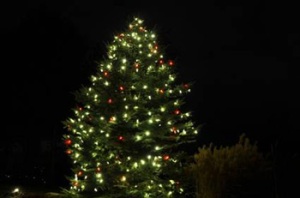Trees. The folks of CLC Tree Services love them. All kinds! And while we generally focus on deciduous trees, we have a liking for coniferous trees too. For those of you with a blank expression on your face, are you wondering what the difference is? Here are some definitions from the Free Dictionary to help you out;
CONIFEROUS:
Any of various mostly needle-leaved or scale-leaved, chiefly evergreen, cone-bearing gymnospermous trees or shrubs such as pines, spruces, and firs.
DECIDUOUS:
Shedding leaves at the end of a growing season and regrowing them at the beginning of the next growing season. Most deciduous plants bear flowers and have woody stems and broad rather than needlelike leaves. Maples, oaks, elms, and aspens are deciduous.
Does that help you out? If the tree sheds its leaves in the winter, it is generally a deciduous tree and coniferous trees stay green all winter. Think Christmas trees, and the like, and you are on the right track. And while there might be more species of deciduous trees in Southern Ontario, when you get up towards the Northern Boreal forest, conifers dominate the landscape. Guaranteed, you have seen plenty of both in London and surrounding areas.
So what are some of the coniferous trees that you might have seen in these parts? Well, spruce, cedar, pine, fir, hemlock, juniper and larch are all found in Ontario. There are different species within some of these groups as well, like the Eastern Red and Eastern White Cedars, the Eastern White, Jack, Pitch and Red Pines, as well as Red and White Spruce. Here are a few facts about some of them;
- White Spruce is the most widespread tree in Canada. Its needles are 15-22 mm long and bluish-green in colour. Native people often used the boughs for bedding. This is one of Ontario’s most popular choices for Christmas trees.
-
Black Spruce is the most common tree in Ontario. Its greyish green needles are 8-15 mm long. It is a common sight in swampy areas.
- Eastern White Pine is Ontario’s tallest tree, and can reach heights of 45 metres, sometimes taller. This made it the tree of choice for making masts out of in sailing days of yore. It has the distinction of having 5 soft needles per cluster. The needles are edible, have a high concentration of vitamin C and can be used to make tea. Small, young trees are also a good choice for Christmas trees.
- Jack Pine have short yellowish-green needles that are 2-4 cm long. The tightly closed cones can stay on the tree for up to 25 years and require high heat (like a forest fire) to open. They can often take on a windswept look, which has attracted the eye of artists, such as Tom Thomson and his iconic Group of Seven friends.
- Eastern White Cedar tolerate poor growing conditions, such as rock cliffs or wet areas. They can live to be extremely old, with some trees in Ontario being dated at over 1000 years old. They have flat, scale-like leaves, with small cones. The bark of the eastern white cedar peels in long, narrow vertical strips.
-
Balsam Fir have flat 2-4 cm long, dark green needles. It is a very aromatic tree with sticky sap. Balsam firs tend to taper to a point at the top. This makes it another ideal choice for Christmas trees, as the tree will also hold its needles long after it has been cut.







Greatings,from Phil at Lamplighter Inn, did you Know that Coniferuos Trees are gymnosperms and Deciduous Trees are angiosperms.??? Naked seeds, and covered seeds. Great post on Trees .!!!!
Hey Phil
Thanks for the support and stopping by with your informative comment!
🙂
[…] Coniferous Trees of Ontario (clctreeservices.wordpress.com) […]
[…] there are plenty of great coniferous trees to choose from in Ontario, not all of them are necessarily native to Southwestern Ontario. If you […]